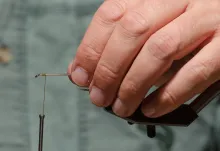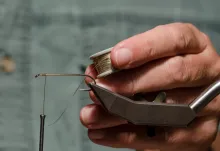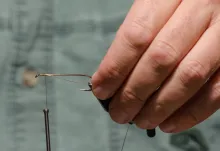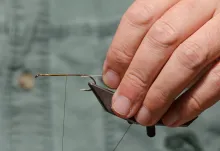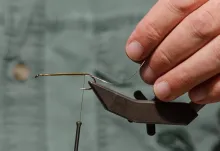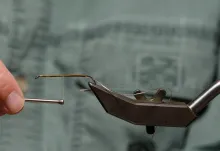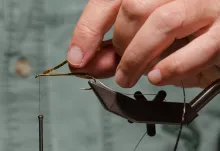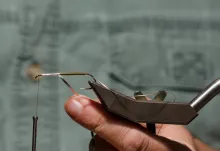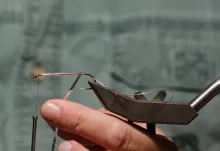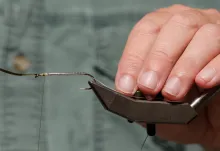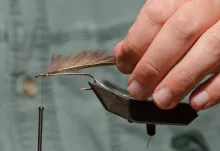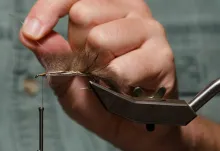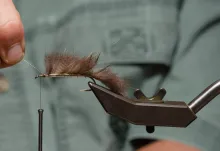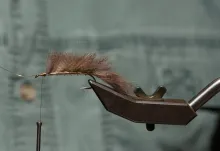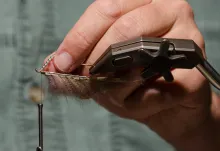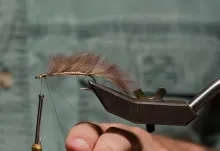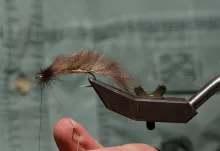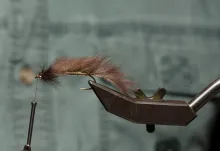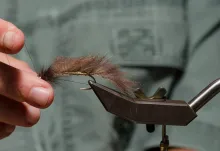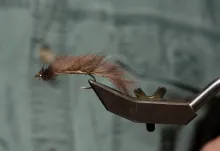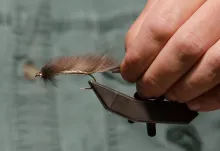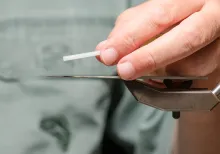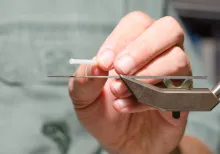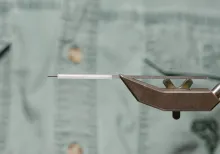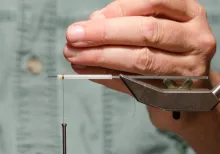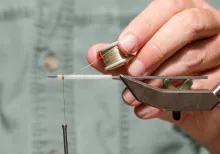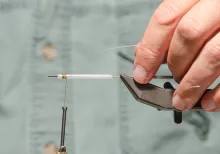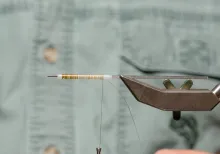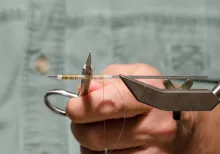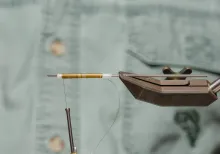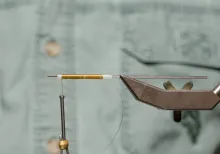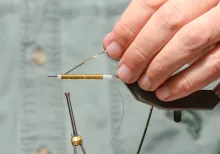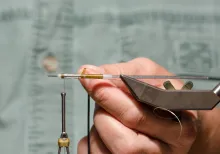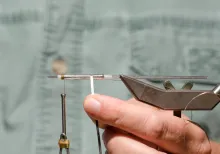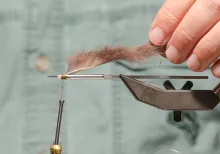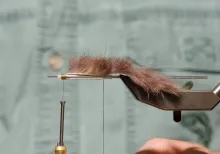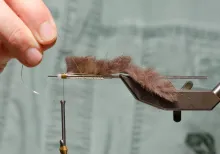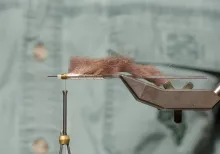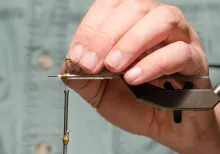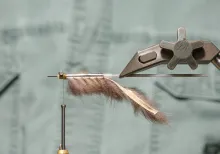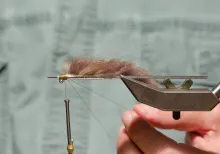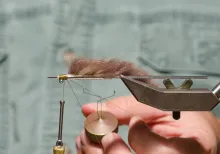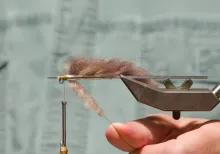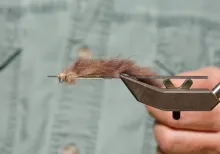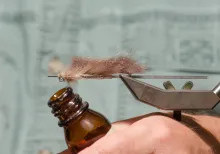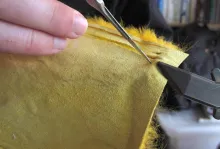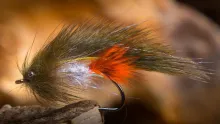The Fair Fly is in many ways a perfect zonker: large, very fishy looking, simple to tie. It's a very good sculpin imitation and an excellent large streamer.
Back in 1996 I was tying at the Fly Fair in the Netherlands. As always I simply tied my usual day-to-day sea trout flies. They generally stir some interest - in Europe because many anglers know and practice sea trout fishing, and in the US because our kind of fishing and the flies we use are sufficiently exotic and different from the US saltwater flies to be interesting. My flies are by no means spectacular. More like the opposite, actually, and that might be what people like.
The first Fair Fly
During one of my tying sessions a spectator asked me to show how to tie a zonker. I have tied and used zonkers quite a bit, so that was no challenge. But not having a pattern prepared, I quickly improvised one. I dug out a skin of my favorite furry animal, the nutria. A long streamer hook, some tinsel. Bead chain was already on my table, and I had a razor blade too.
So I cut a couple of zonker strips, made a tinsel body, added a nutria zonker wing, eyes, a hair hackle and a bulky, dubbed head, and viola! A new fly was born. It didn't have a name by then, but it sure looked very fishable and very good.
I'm almost sure I gave this first fly to the gentleman who inspired it, but since the fly wound up quite good looking, I tied several, and started fishing them as soon as I came home. Tied at the Fly Fair first, I soon named the fly The Fair Fly.
A large fish fly
A year later I was in New Jersey for another show, and also whipped out a few Fair Flies while demoing fly tying. We were to fish the Connetquot, a trip arranged by local Bob Perry, who had noticed the fly during one of my tying sessions. When we approached a bend in the river with some overhanging trees and an undercut bank, Bob pointed to a spot under the trees and said: "Tie on one of those large furry flies from the show, and cast it as close as you can to the bank over there. Let it sink a bit and then strip!"
Just my kind of fishing. I had been fishing minute nymphs, trying to entice the overwhelming number of fish in the gin clear stream, but had very little luck.
I did as he suggested.
The fly almost hit the bank and sunk a foot into the water before I stripped. A large fish immediately ambushed the fly and got hooked. It put up a very good fight and disturbed the whole pool with a good run and several jumps... and spit the hook and escaped.
The hook
I tie this fly on one of my favorite hooks, the long shank B800 from Kamasan. Together with its sibling the straight eye B840 they are my stable streamer hooks for large muddlers, zonkers, Thunder Creeks and such. They are good looking, as sharp as they should be and stand my local saltwater quite well.
The body is a simple tinsel body and the rib holds the zonker strip. If you can't find nutria look for mink and in a tight spot maybe rabbit, but preferably a little frizzy and not too long haired. For smaller sizes a well cured squirrel skin can also be good, but don't go too small.
For the fun of it I have also tied some of these on tubes. The large zonkers lend themselves well to tubes, and the tinsel body looks brilliant tied on a tube. I do like the fly better with a cone rather than eyes when tied on a tube. This of course removes it a bit from the very baitfish-looking to a more traditional tube fly like the ones you see used for salmon. But the added weight of a cone will at the same time help the fly go down and add that sexy, jigging motion.
Martin Joergensen
Weight and size
The fly isn't large by the measure used by large streamer fans, but compared to my normal coastal flies it's pretty big, and for use in a stream when targeting brown trout it's well above average. When fishing it in a current you might want to add some weight to the fly. Due to its fluffy nature it tends to be unwilling to dive. You can fish it on a sinking line or leader or you can add some weight.
Use dumbbell eyes in stead of the fairly light bead chain eyes or add some weight to the fly. Weight under the body will ruin the nice, smooth tinsel surface, but if you replace the tinsel with some kind of silver braid, you can cover up the bulk of the weight.
If you tie the fly on a tube, consider using a metal tube like brass, copper or even steel. Aluminum is very light and so close to plastic that it makes little difference.
Tied on a hook - step by step
|
|
|
|
|
|
|
|
|
|
|
|
|
|
|
|
|
|
|
|
|
|
|
|
|
|
|
|
|
|
|
|
|
|
|
|
|
|
|
|
Fishing the fly
I fish the fly on a floating or neutral line when using it for sea trout. It's not bad to cast in spite of size and materials, but does of course require a calm and steady casting rhythm.
The fly is fished like most sea trout flies: cast, let sink a bit, strip back almost as you please. The fly sinks slowly and isn't prone to going to the bottom or snagging, so you can pause now and then, allowing the fly to sink a bit. It dives head first and jigs a bit when you pull again.
When used in streams either weigh the fly or use a sinking line or leader. Cast down and across and mend a bit upstream to let the fly sink. Let it move across the current, maybe retrieving slowly or inducing a bit of movement in the fly by tipping the rod up and down or tugging slightly on the line. Don't be afraid to cast close to the bank or under overhanging bushes and trees, and if you are fishing from the bank, don't forget to fish the fly all the way to your own bank, and maybe even "mending in" to get it even closer. Fish may very well attack the fly as you retrieve it along your own bank. Large fish like the shelter and stay close to undercut or steep banks during the daylight, but can still be tempted by a large fly.
The Fair Fly is an excellent fly for fishing in the dark. Its prominent profile and dark color makes it a good imitation of a small fish hiding in the shelter of the low light, fleeing the large and hungry fish out to get a protein rich meal.
I have shown the fly on GFF before, but that was back in 2001. It has also been featured in a variation called the Twospotted Fair Fly. This time there is a detailed tying sequence and step-by-step photos for the original as well as nice new color photos of the fly - and the tube version of course.
Tied on a tube - step by step
Exchange the hook with a plastic tube in the materials list. Remember that the tube requires quite a lot more tinsel, so don't cut that short.
|
|
|
|
|
|
|
|
|
|
|
|
|
|
|
|
|
|
|
|
|
|
|
|
|
|
|
|
|
|
|
|
|
|
|
Martin Joergensen
Hand picked for this article
- Log in to post comments



